Species Diversity of Hard Ticks (Acari : Ixodidae) Infesting M’bororo and Goudali Cattle Breeds from Cameroon at the Owendo Abattoir in Gabon
Lin-Sosthène S1, Armel KA2,3, Lendzele SS2*, Roland ZKC2, Rodrigue MN2, Dieudonné MM4, Julie B5 and François MJ1,4,5
1Institut de Recherches Technologiques (IRT-CENAREST), BP : 9154, Libreville, Gabon
2Institut de recherche en Ecologie Tropicale (IRET-CENAREST), BP : 13354, Libreville, Gabon
3Université d’Abomey-Calavi (UAC), 05 BP : 1604, Cotonou, Benin
4Institut de Recherches Agronomiques et Forestières (IRAF-CENAREST), BP : 2246, Libreville, Gabon
5Université des Sciences et Techniques (USTM), BP : 901, Franceville, Gabon
Received Date: 08/09/2020; Published Date: 06/10/2020
*Corresponding author: Sevidzem Silas Lendzele, Institut de recherche en Ecologie Tropicale (IRET-CENAREST), BP : 13354, Libreville, Gabon. Tel: +24165186510 ; E-mail : sevidzem.lendze@gmail.com
Abstract
Trade cattle movement from Cameroon to Gabon is common, but no investigation reports the risk posed by this activity in terms of ticks infestation and transmission of ticks borne diseases. In order to investigate on this, a survey was designed to identify and characterise the predilection sites of tick species on trade cattle breeds brought to the Owendo abattoir in Gabon. This abattoir survey was conducted from October to December 2008. The whole body surface of cattle was checked to remove ticks of all developmental stages. The ticks were identified under a LEICA MZ 7-5 binocular microscope with the aid of standard taxonomic keys. A total of 32 male zebu M’bororo and Goudali were examined in this study. We collected 968 ticks that were regrouped under 4 genera and 7 species: Boophilus decoloratus (41%), Amblyomma variegatum (40.5%), Boophilus annulatus (8.5%), Hyalomma truncatum (5%), Rhipicephalus lunalutus (3.7%), Boophilus spp. (0.8%) and Rhipicephalus spp. (0.6%). Boophilus decoloratus and Amblyomma variegatum were the most abundant taxa. All the ticks identified were collected from ten (10) anatomical regions: head, ear, back, dewlap, flank, abdomen, genito-anal region, tail, forelegs and hind legs. The predilection sites of ticks differed with cattle breed where the genito-anal region and the neck were preferred by those on the Goudali whereas the genito-anal zone and the abdomen were preferred by those on the M'bororo. The tick species identified are potential vectors of several zoonotic diseases. This survey provides baseline data that could be used to control ticks and tick borne disease in Gabon.
Keywords: Cattle; Ticks; Species; Predilection Sites; Abattoir; Owendo-Gabon
Introduction
Ticks are blood-sucking ectoparasites of several vertebrates [1]. They have a severe impact on health and animal production because of their direct action on parasitized animals (blood intoxification, skin lesions, and allergies), but especially because of their role as vectors of many pathogens such as protozoa, rickettsiae, bacteria, and viruses, responsible for serious diseases in animals [2,3,4]. These Tick-Borne Diseases (TBDs) are of considerable importance for the health and productivity of livestock [5,6,7]. They are widespread throughout the world and especially in tropical and subtropical zones.
The phenomenon of transboundary animal movement has led to high re-infestation of diseases and vector free zones [7] and this animal movement network is well developed in Central Africa [8]. The study of ticks diversity in the peri-urban zones of Ngaoundere that represent one of the excellent cattle breeding areas of Cameroon has already been documented [4,7,9,10,11]. An interesting breakthrough in the ticks survey of Cameroon is on the first report of the acaricide and insecticide resistant Rhipicephalus (Boophilus) microplus [7]. The source of infestation of R. microplus was via trade cattle from neighbouring Nigeria where this species has been reported [7]. A study conducted at the Owendo abattoir reported the occurrence of Hyalomma impeltatum removed from the skin of Kuri beef imported from the Lake Chad basin into Gabon [12].
In Gabon, a study conducted in Libreville on 56 dogs, revealed the presence of 400 ticks regrouped under two species: Rhipicephalus sanguineus and Amblyomma variegatum [13]. Also, 28 species of ticks parasitizing domestic and wild animals in the country were reported [14]. The existence of these tick species constitutes a potential danger for animals in local farms as well as humans. However, information on ticks that can transmit diseases to livestock in Libreville and the rest of the country remains weak.
The objective of this study is to identify the species of ticks and their predilection sites on M’bororo and Goudali cattle breeds imported from Cameroon into Gabon.
Materials and Methods
Study Site
The study was conducted at the Owendo abattoir [15]. This abattoir covers 2 hectares of land and is owned by the state. It includes a waiting area, a restraining corridor, and areas for slaughtering and washing of carcasses. Owendo is located 15 km south of Libreville (latitude 0° 18’26 "North and longitude 9° 29’40" East) [16] (Figure 1) and consists of 79,300 inhabitants [17] (DGS-RGPL, 2015) and built on an uneven oro-hydrographic complex, dotted with multiple hills and valleys that are cris-crossed by rivers [15]. The climate is a hot and humid equatorial type with a rainy season (September to May) and a dry season (May to September). The temperatures range between 22°C and 26°C while the annual rainfall is 1500 to 3000 mm. Relative humidity is around 85% [18]. Most of the cattle brought to this abattoir originates from Cameroon and about 80 % are Goudali and M’bororo breeds.
Collection and Conservation of Ticks
Ticks were removed from cattle before their slaughter. After thorough visual examination and careful palpation of the entire animal body surface [19], ticks were gently removed using blunt forceps [13]. The collected ticks were put in well labelled tubes consisting of a special liquid composed of 70 % ethanol, 15 % water, 5 % glycerol and 1 % chloroform [20]. Glycerol was used because it helps to prevent ticks from drying when examined in the open air. Chloroform helps to prevent the decolorization of ticks.
Identification of Ticks
Ticks collected from cattle were identified upto the genus and species levels at the Vector Ecology Laboratory (LEV) of the Research Institute for Tropical Ecology (IRET). Identifications was made under a LEICA MZ 7-5 brand 10 X 21B binocular magnifying glass (fitted with two lamps with powerful and orientable periscopic lighting) and using identification keys [20,21,22,23].
Study Cattle
In this study, thirty two (32) cattle imported from Cameroon were included in the study. The animals were male zebus of the M’bororo and Goudali breeds. The weight of these cattle varied between 350 and 500 kg. Their size was between 130 and 138 cm for individuals of the Goudali breed and less than 140 cm for those of the M’bororo breed.
Data Analysis
The prevalence of tick species was determined using the following formula:
Prevalence (%) =(Number of of a particular species)/(Total number collected)×100
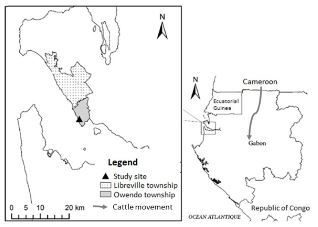
Figure 1: Location of study site (black triangle) [18].
Result
Ticks Species Diversity and Prevalence
A total of 968 ticks were collected and classified into 4 genera and 7 species. The species of ticks identified consisted of Boophilus decoloratus (40.91%), Amblyomma variegatum (40.49%), Boophilus annulatus (8.47%), Hyalomma truncatum (4.96%), Rhipicephalus lunalutus (3.72%), Boophilus spp. (0.83%), and Rhipicephalus spp. (0.62%) (Table 1).
Proportions of Ticks Genera with Cattle Breeds at the Owendo Abattoir
Morphological identification of ticks revealed that cattle were infested with four (4) genera: Boophilus (n = 486; 50.2%), Amblyomma (n = 392; 40.5%), Hyalomma (n = 48; 4.96%), and Rhipicephalus (n = 42; 4.34%) (Table 2).
Regarding the zebu Goudali, the predominant genera were Amblyomma (n = 174; 44.16%) and Boophilus (n = 172; 43.66%). In contrast, the genera Rhipicephalus (n = 26; 6.6%) and Hyalomma (n = 22; 5.58%) were poorly represented (Table 2). For the M’bororo cattle, the most dominant taxonomic groups consisted of Boophilus (n = 314; 54.7%) and Amblyomma (n = 218; 37.98%). In contrast, the least frequent genera were Hyalomma (n = 26; 4.53%) and Rhipicephalus (n = 16; 2.79%) (Table 2).
Number of Ticks Species with Cattle Breed at the Owendo Abattoir
For the Goudali breed, the most common tick species was Amblyomma variegatum (n = 174), followed by Boophilus decoloratus (n = 138). In contrast, the least encountered species were Boophilus spp. (n = 6) and Rhipicephalus spp. (n = 2) (Figure 2).
The M’bororo cattle breed was highly infested with Boophilus decoloratus and Amblyomma variegatum tick species (Figure 3). In contrast, Boophilus annulatus and Hyalomma truncatum were moderately collected. The other ticks species were rare (Figure 3).
Predilection Sites of Ticks Developmental Stages and Cattle Breeds
In the Goudali, the preferred attarchment points of ticks were mainly the genito-anal zone (98 adults; 24 nymphs) followed by the neck (86 adults; 22 pupae). The other anatomical regions of cattle were less infested with ticks (Figure 4).
Concerning the M’bororo, the preferred attachment sites of ticks were mainly the genito-anal area (n = 252) and the abdomen (n = 120). The other parts of the body of study animals were weakly infested by ticks (Figure 5).
Number of Nymph and Adult Ticks collected from Goudali
Regarding the Goudali breed, the nymphs of Amblyomma variegatum (n = 52), Boophilus decoloratus (n = 10) and Boophilus annulatus (n = 2) were most frequent. However, nymphs of other tick species were not collected (Figure 6). As for the adult stages of ticks, individuals of Boophilus decoloratus (n = 128) and those of Amblyomma variegatum (n = 122) were most frequent (Figure 6).
For the M’bororo cattle breed, only the nymphs of Amblyomma variegatum (n = 72) and those of Boophilus decoloratus (n = 8) were collected. Concerning the adult ticks, we collected all the five species of ticks but in varying proportions. The most frequent species were Boophilus decoloratus and Amblyomma variegatum with 240 and 146 adults respectively. The rest of the tick species were poorly represented, including 54 adults of Boophilus annulatus, 26 adults of Hyalomma truncatum, 12 of Rhipicephalus lunalutus and 4 adults of Rhipicephalus spp. and 2 adults of Boophilus spp. Generally adults were by far more frequent than nymphs (Figure 7).
Table 1: Prevalence of ticks species on cattle in the Owendo abattoir.
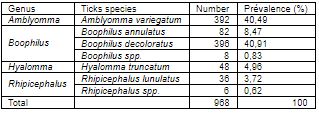
Table 2: Proportion of ticks on the cattle breeds at the Owendo abattoir.

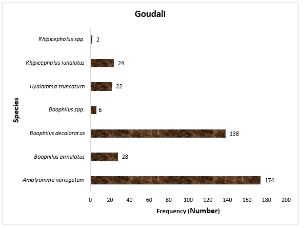
Figure 2: Number of ticks species with Goudali cattle breed.
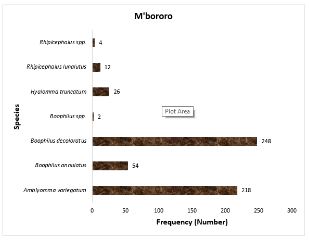
Figure 3: Number of ticks species with M’bororo cattle breed.
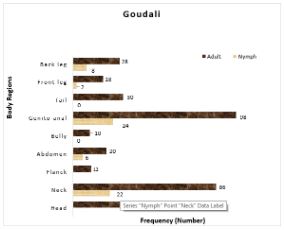
Figure 4: Predilection sites of ticks developmental stages on Goudali.

Figure 5: Predilection sites of ticks on M’bororo.

Figure 6: Number of nymph and adult ticks collected from Goudali cattle breed.

Figure 7: Number of nymph and adult ticks collected from M’bororo cattle breed.
Discussion
During this study, a total of 968 ticks were collected. A qualitative analysis of the species composition of these ticks revealed that cattle brought to the Owendo abattoir from Cameroon were infested with 7 species: Boophilus decoloratus, Amblyomma variegatum, Boophilus annulatus, Hyalomma truncatum, Rhipicephalus lunalutus, Boophilus spp., and Rhipicephalus spp. It is the first time that the genus Hyalomma (Hyalomma truncatum) is reported in Gabon [14].
All the ticks species identified in this study belonged to the family Ixodidae (hard ticks) [23]. Regarding the species diversity, our results are contrary to those of other authors [13,12] who found only two species of ticks on the animals examined. The collection of Rhipicephalus sanguineus and Amblyomma variegatum from dogs in Libreville (Gabon) has already been reported [13], while another survey only reported Hyalomma impeltatum in the same locality [12]. On the other hand, Amblyomma splendidum and Rhipicephalus spp. were identified [24] on cattle from the Nyanga ranch (southern Gabon). Among the seven species of ticks identified, Boophilus decoloratus and Amblyomma variegatum recorded the highest prevalence. The abundance of B. decoloratus and A. variegatum was also reported in Benin and Ethiopia [25,26]. This is probably due to the fact that these two ticks parasitize a wide range of vertebrate hosts, notably cattle, dogs, and buffalos etc in Africa [14].
Of all the ticks species identified, four can transmit pathogens which cause zoonoses such as human such as Rickettsia africae, yellow fever virus (A. variegatum), and Chlamydia (B. annulatus, H. truncatum) [27]. Consequently, the importation of these Bovidae to Gabon constitutes a potential risk of introduction of various infectious agents [4,8]. In fact, B. decoloratus transmits a parasite of the genus Babesia which cause bovine babesiosis. On the other hand, A. variegatum is the vector of Cowdria ruminatium causing cowdriosis in ruminants and dermatophilosis in cattle. In addition, this tick can also infect humans with Rickettsia conorii, Coxiella brunetii, Crimean and Congo hemorrhagic fever virus, bhanja virus and dugbe virus [28]. Finally, Hyalomma truncatum can transmit Babesia caballi. All these species of ticks mostly infested the genito-anal area and the neck (in the Goudali) or the genito-anal area and the abdomen in the M’bororo. Our result is similar to that of Moubamba [13] who noted that the predilection sites of ticks ecountered on dogs in Libreville is the genito-anal area.
Conclusion
The high ticks species diversity on imported cattle from Cameroon into Gabon indicates high risk of possible transmission of dangerous zoonotic diseases. Therefore, it would be important to conduct regular entomological surveys in the country's animal farms, as well as create veterinary checkpoints for imported livestock because Gabon imports large numbers of cattle from neighboring countries including Cameroon.
Acknowledgement
The authors are grateful for the technical assistance of the Owendo Abattoir Manager and his collaborators. This work was conducted thanks to the institutional, logistical and material support of the National Higher Institute of Agronomy and Biotechnologies (INSAB-USTM) and, of the Vectorial Ecology Laboratory (LEV) of the Research Institute in Tropical Ecology (IRET-CENAREST).
Competing Interest
The authors have declared that no competing interest exists.
References:
- Nyangiwe N, Yawa M and Muchenje V. Driving forces for changes in geographic range of cattle ticks (Acari: Ixodidae) in Africa: A review. South Afric. J. Anim. Sci. 2018;48:829-841.
- Benchikh-Elfegoun MC, Benakhla A, Bentounsi B, Bouattour A and Piarroux R. Identification et cinétique saisonnière des tiques parasites des bovins dans la région de Taher (Jijel) Algérie. Ann. Méd. Vét. 2007;151:209-214.
- Marcelino I, De Almedia AM, Ventosa M, Pruneau L, Meyer DF, Martinez D, et al. Tick borne disease in cattle: Applications of proteomics to develop new generation vaccines. J. Proteom. 2012;75:4232-4250.
- Abdoulmoumini M, Cyril N, Lendzele S, Kingsley M, Njongui J and Pagnah Z. Bovine babesiosis and anaplasmosis in some cattle farms in the Vina division. International J. Livestock Res. 2017;7:69-80.
- Hounzangbe-Adote MMS, Linton E, Koutinhouin GB, Losson B and Moutairou K. Impact des tiques sur la crois-sance des agneaux Djallonké. Ann. Méd. Vét. 2001;145:210-216.
- Yao-Acapovi GL, Mavoungou JF and Sevidzem SL. Tick population on large and small ruminant species in the Port-Bouët cattle market in Abidjan, Ivory Coast. Livestock Res. Rural Develop. 2018;30:1-11.
- Silatsa BA, Simo G, Githaka N, Mwaura S, Kamga RM, Oumarou F, et al. A comprehensive survey of the prevalence and spatial distribution of ticks infesting cattle in different agro‑ecological zones of Cameroon. Parasites and Vectors. 2019;12:1-14.
- Motta P, Thibaud P, Ian H, Saidou MH, Ngu NV, Tanya V, et al. Implications of the cattle trade network in Cameroon for regional disease prevention and control. Sci. Report. 2017;7:43932.
- Mamoudou A, Nguetoum NC, Zoli PA, Sevidzem SL. Identification and infestation of ticks on cattle in the peri-urban area of Ngaoundere, Cameroon. J. Vet. Sci. Med Diagn. 2016;5:4.
- Abah S, Njangloga AM, Zoli AP, Mamoudou A, Sevidzem SL, Souley A, et al. Commercial acaricides in pour-on formulation react differently in reducing tick numbers on cattle in extensive and intensive management systems in Bockle, North Cameroon. Direct Res. J. Agric. Food Sci. 2017;5:232-238.
- Abah S, Abel W, Njan Nlôga AM, Lendzele SS, Mamoudou A, Dickmu S, et al. Tick infestation and haematocrit alteration of cattle in Boklé-Garoua (Northern Cameroon). Int. J. Curr. Res. Biosci. Plant Biol. 2019;6:29-34.
- Mbina DM, Maganga GD and Ndoutoume AN. A Kuri Beef (Bos Taurus) Imported From the Lake Chad Has Introduced Hyalomma Impeltatum (Acari: Ixodidae), an Anthropophilic Tick To Gabon. European J. Med. Hlth Sci. 2019;1:4.
- Mbina DM. Identification et distribution des espèces de tiques (Acari : Ixodidae) qui infestent les chiens à Libreville. Ann. Méd. Vét. 2006;150:193-196.
- Pourrut X, Emane KA, Camicas JL, Leroy E, Gonzalez JP. Contribution to the knowledge of ticks (Acarina: Ixodidae) in Gabon. Acarologia. 2011;51:465-471.
- Mbouloungou A, Koumba AA, Mombo JB, Iyangui NN, Mavoungou JF, Djeki J. Géographie du Paludisme dans la région de Libreville-Owendo-Akanda, Gabon. European Sci. J. 2019;15:362-382.
- Musavu-Moussavou B, Mougola WLB. Bivalves et gastéropodes du Turonien du port d’Owendo dans le bassin côtier nord gabonais. Revue CAMES, Science de la vie, de la terre et agronomie. 2016;4:26-35.
- DGS-RGPL (Direction Générale de la Statistique du Gabon-Recensement Général de la Population et des Logements). Résultats globaux du Recensement Général de la Population et des Logements de 2013 (RGPL, 2013) du Gabon, Libreville. 2015;247.
- Bayendi-Loudit SM, Ndoutoume ANA, Francis F. Le maraîchage périurbain à Libreville et Owendo (Gabon) : pratiques culturales et durabilité. Cahiers d’Agrics. 2017;26:1-10.
- Payne VK, Mbafor FL, Pone JW, Tchoumboué J. Preliminary study of ectoparasites of horses in the western highlands of Cameroon. Collection Vet. Med. Sci. 2017;1-8.
- Walker AR, Bouattour A, Camicas JL, Estrada P, Horak I, Latif A. Ticks of Domestic Animals in Africa: A guide to identification of species. Bioscience Reports, Edinburgh EH10 5QR, Scotland, U.K. 2003;211.
- Madder M. Key to the families and genera of the common ticks. Institute of Tropical Medecine, Antwerp, Belgium. 1999;27.
- Voltzit OV, Keirans JE. A review of african amblyomma species (Acari, Ixodida, Ixodidae). Russie. 2003;196-197.
- Pérez-Eid C. Les tiques: Identification, biologie, importance médicale et vétérinaire. Edition Tech&Doc, 11, rue Lavoisier, 750008 Paris. 2007;314.
- Ntsovi J. Etude des tiques infestant les bovins du ranch Nyanga (Sud du Gabon) et de leur infection par les arbovirus. Mémoire de fin de cycle d’Ingénieur Agronome, option Productions Animales. Institut National Supérieur d’Agronomie et de Biotechnologies. Université des Sciences et Techniques de Masuku, Franceville, Gabon. 2017;79.
- Farougou S, Kpodekon M, Tchabode DM, Youssao AKI, Boko C. Abondance saisonnière des tiques (Acari : Ixodidae) parasites des bovins dans la zone soudanienne du Bénin : cas des départements de l’Atacora et de la Donga. Ann. Méd. Vét. 2006;150:145-152.
- Mekonnen S, Hussein I, Bedane B. The distribution of ixodid ticks (Acari : Ixodidae) in central Ethiopia. Onderstepoort J. Vet. Res. 2001;68:243-51.
- Ndip LM, Eric B, Walker DH and Mc Bride JW. Detection of Rickettsia africae in patients and ticks along the coastal region of Cameroon. The American Soc. Trop. Med. Hyg. 2004:71:363-366.
- Chartier C, Itard J, Morel PC and Troncy P. Précis de parasitologie vétérinaire tropicale. Tech&Doc, 11 rue Lavoisier F 75384 Paris, cedex. 2000;08:773.

